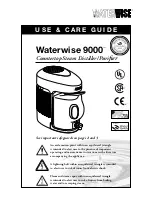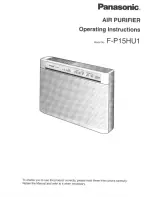
Page3
DO NOT LET HEAT EXCHANGER HANG
FROM ITS FLEXIBLE LINE
SUPPORT HEAT EXCHANGER
WEIGHT USING HOOKS
AND CHAINS PROVIDED
OR STAND ON FIRM
GROUND.
DROPS OF CONDENSATE
MAY APPEAR HERE
Fig 1
PAC240 SHOWN
EXTERNAL HEAT EXCHANGER (HEX).
The heat exchanger must stand external to the area
being cooled and, preferably, in the outside atmosphere.
It can stand freely on a flat surface or, in the case of the
PAC.240 may be hung in the upright position from a
sindow sill, balcony etc, see Fig 1. USE THE CHAINS
PROVIDED TO SUPPORT THE HEAT EXCHANGER.
IT WOULD BE HIGHLY DANGEROUS TO SUPPORT
THE HEAT EXCHANGER BY MEANS OF THE
FLEXIBLE LINES ALONE.
CONDENSATE.
In operation, the room unit is constantly condensing water
vapour out of the atmosphere (reducing relative
humidity). This water has to be drained away. An
automatic condensate pump is fitted inside all room
units. The flexible hose outlet from the condensate pump
runs to the outside, inside the flexible sheath , the
condensate is deposited in the base of the heat
exchanger, considerable re-evaporation of this water
takes place on the warm air stream passing through and
around the heat exchanger, but please remember that
there will also be a degree of dripping through the base
of the heat exchanger.
HAVE GREAT REGARD FOR THIS CHARACTERISTIC
WHEN POSITIONING THE EXTERNAL HEAT
EXCHANGER.
The flexible water pipes should be routed so as to avoid
any possibility of kinking or unnecessary restrictions to
the flow of water inside. Also, remember that plastic
and rubber becomes much more flexible when warm
and, as a result, much more susceptible to distortion.
5) MACHINE LINK-UP.
Ensure the mains supply lead to the room unit is
disconnected. A 5m (extendable to 30m) line set to
connect water between the room unit and the external
heat exchanger will have been supplied. The water pipe
connections are by means of “quick connect couplers”.
These are simple “push-on” connectors which, when
disconnected (after pulling back sprung loaded locking
ring), re-seal the water system on either side. The
complete system will have been filled with the necessary
amount of water/antifreeze prior to its arrival on site. A
condensate drain pipe coupler 6mm clear polythene
(push fit), should also be connected. Having made the
couplings, the system is operational immediately.
WARNING !
This unit MUST be transported and operated in the upright
position at all times.
1) COMMISSIONING INSTRUCTIONS
As standard, these units are supplied with a NEMA power
plug attached to the power supply cord. They require a 208/
230volt 1 phase 60Hz supply with the following appropriately
protected current rating:-
PAC.240 20 AMPS
PAC.320 30 AMPS
The size of any extension cable that may be used is as
follows and must be rated above the fuse size also allowing
for voltage drop and be suitable for the environment:
PAC.240
14AWG up to 30 feet
12AWG over 30 feet
PAC.320
10AWG up to 30 feet
8AWG over 30 feet
If the cable is on a "cable drum" then ensure that it is
completely unwound; serious complications will occur
otherwise.
2) SYSTEM DESCRIPTION.
The system comprises a room unit cooling section, an
external heat exchanger and the two are inter-connected
by means of flow and return water pipes and an electrical
supply to the heat exchanger fan.The room unit is fitted
with an automatic condensate disposal pump which
discharges the condensate via a small plastic pipe
into
the base of the external heat exchanger
and all
interconnecting pipes and electrics are enclosed in a flexible
plastic sheath. In addition, both ends of each pipe are fitted
with "quick connect" couplings that open on coupling but
reseal to become water tight on disconnect.
3) AIRFLOW
The angled outlets at the top of the room unit are fitted with
air grilles that allow the angle of air outlet to be adjusted
vertically and horizontally and, in conjunction with the fan
speed control switch, the air velocity and direction can be
carefully set up to obtain maximum coverage of the area
being cooled without causing drafts. Care should be taken
to avoid outlet air being obstructed as this will cause the air
to "eddy" around the unit resulting in recirculation and short/
inaccurate cycling of the machine. Ideally, cold air should
be directed to create a "blanket" all across the ceiling area
allowing natural convection to drop the air over the whole
area at very low velocity.
4) SITING
Ideally, the room unit should be positioned equidistant along
the shortest wall in the room
blowing down the length of
the room. If there is more than one unit in the same area,
then they would normally be positioned side by side, and
equidistant along the long wall, all pointing in the same
direction. Sometimes it may be necessary to position units
around the perimeter of an area but, in this case, great
care should be taken to avoid one unit blowing cold air
straight into another which will adversely affect the machine
operation. Good and correct air flow is, perhaps, the single
most important aspect of satisfactorily applying portable
air conditioners. If in doubt seek the advice of your supplier.
Содержание PORTA TEMP 240
Страница 2: ...Page 2 BLANK PAGE...
Страница 10: ...Page 10 BLANK PAGE...
Страница 11: ...Page11 BLANK PAGE...
Страница 12: ...Page 12 BLANK PAGE...






























